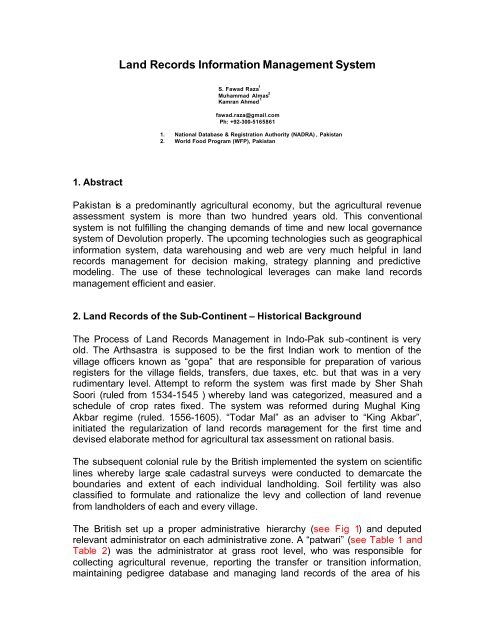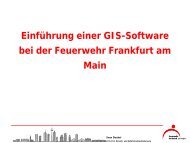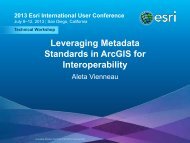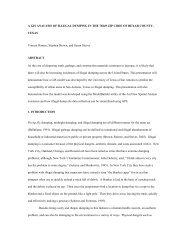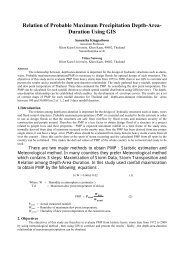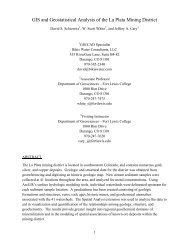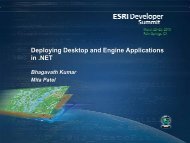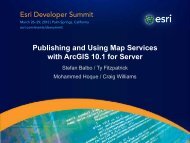Land Records Information Management System
Land Records Information Management System
Land Records Information Management System
You also want an ePaper? Increase the reach of your titles
YUMPU automatically turns print PDFs into web optimized ePapers that Google loves.
<strong>Land</strong> <strong>Records</strong> <strong>Information</strong> <strong>Management</strong> <strong>System</strong><br />
S. Fawad Raza 1<br />
Muhammad Almas 2<br />
Kamran Ahmed 1<br />
fawad.raza@gmail.com<br />
Ph: +92-300-5165861<br />
1. National Database & Registration Authority (NADRA) , Pakistan<br />
2. World Food Program (WFP), Pakistan<br />
1. Abstract<br />
Pakistan is a predominantly agricultural economy, but the agricultural revenue<br />
assessment system is more than two hundred years old. This conventional<br />
system is not fulfilling the changing demands of time and new local governance<br />
system of Devolution properly. The upcoming technologies such as geographical<br />
information system, data warehousing and web are very much helpful in land<br />
records management for decision making, strategy planning and predictive<br />
modeling. The use of these technological leverages can make land records<br />
management efficient and easier.<br />
2. <strong>Land</strong> <strong>Records</strong> of the Sub-Continent – Historical Background<br />
The Process of <strong>Land</strong> <strong>Records</strong> <strong>Management</strong> in Indo-Pak sub-continent is very<br />
old. The Arthsastra is supposed to be the first Indian work to mention of the<br />
village officers known as “gopa” that are responsible for preparation of various<br />
registers for the village fields, transfers, due taxes, etc. but that was in a very<br />
rudimentary level. Attempt to reform the system was first made by Sher Shah<br />
Soori (ruled from 1534-1545 ) whereby land was categorized, measured and a<br />
schedule of crop rates fixed. The system was reformed during Mughal King<br />
Akbar regime (ruled. 1556-1605). “Todar Mal” as an adviser to “King Akbar”,<br />
initiated the regularization of land records management for the first time and<br />
devised elaborate method for agricultural tax assessment on rational basis.<br />
The subsequent colonial rule by the British implemented the system on scientific<br />
lines whereby large scale cadastral surveys were conducted to demarcate the<br />
boundaries and extent of each individual landholding. Soil fertility was also<br />
classified to formulate and rationalize the levy and collection of land revenue<br />
from landholders of each and every village.<br />
The British set up a proper administrative hierarchy (see Fig 1) and deputed<br />
relevant administrator on each administrative zone. A “patwari” (see Table 1 and<br />
Table 2) was the administrator at grass root level, who was responsible for<br />
collecting agricultural revenue, reporting the transfer or transition information,<br />
maintaining pedigree database and managing land records of the area of his
jurisdiction that is known as a patwar circle (see Fig 1). In estimating the number<br />
of patwaries required, the following averages for the province were taken into<br />
account:<br />
• patwari to be responsible for 8000 acres.<br />
• 3300 acres of cultivated area.<br />
• 4.5 mauzas.<br />
• 4440 khasra<br />
• or 1200 khatunis<br />
(See Table 3 for terminology). In applying these averages to the statistics of the<br />
district, reference was made to the exceptional circumstances such as the<br />
distance to be traversed, the level of mountainous character of the country, the<br />
simplicity or complicated nature of the tenures, or the absence of prevalence of<br />
fluctuating assessments.<br />
After passing about two hundred years the system retain the same character and<br />
only minor changes have been made according to the needs of the time. If we<br />
study the attribute datasets in detail like ownership records, land parcel<br />
information, transfer history, farmer information, pedigree records and other, it<br />
will be clear to us that it is developed on databases principles. The primary and<br />
foreign keys are very well defined. This makes for systematic navigation of<br />
various record sets through different registers.<br />
3. <strong>Land</strong> <strong>Records</strong> in Pakistan:<br />
The conventional land record system in Pakistan is being administered through<br />
the officials that can be categorized into two classes on the basis of their<br />
functions (Table 1). This system has borrowed this hierarchy (see Fig 1) from<br />
British, but the new millennium has heralded a new system based on devolution<br />
of power in teune with local governance in Pakistan. The new organizational<br />
hierarchy for the system of Devolution is also given in Fig 2<br />
Although the system of local governance has changed for the better<br />
management, but the mechanism of land records handling and revenue<br />
assessment remains same as followed since Mughal era. Before discussing<br />
various data constructs of the conventional land record system it will be better to<br />
take a look at various nomenclatures that are frequently used (Table3). The land<br />
records data is maintained at Tehsil offices whereby following record sets are<br />
developed at the time of settlement.<br />
1. Mussavie (Index Map)<br />
2. Khatuni Pamaish bandobast<br />
3. Chittha Shajra Nasb Malkan (Pedigree Sheets)<br />
4. Chittha Wajab-ul-arz (Customs Book)<br />
5. Field Book
6. Index Survey khasra Number<br />
7. Index Radeef War Malkan and Murthnan<br />
8. Missal Haqiat<br />
9. Fard Partal<br />
10. Note of Changes in kind of soil<br />
11. Statement of Right in wells and Tube wells<br />
12. Order of Revenue Officer determining the assessment<br />
13. Order of Revenue Officer distributing the assessment over holding<br />
14. Index of Mutations<br />
15. Last attestation of the Revenue Officer.<br />
4. Study Objectives:<br />
‣ Understand existing land record system of Pakistan.<br />
‣ Identify flaws and shortcomings in the system.<br />
‣ Suggest procedure for developing a computerized <strong>Land</strong> <strong>Records</strong><br />
<strong>Information</strong> <strong>Management</strong> <strong>System</strong> and its implementation plan, for decision<br />
making and strategy planning.<br />
5. Data Organization in Conventional <strong>System</strong><br />
There are two components of land record data.<br />
• Geographic data is recorded on special kind of paper maps for each<br />
village. These are known as the Mussavies (Its reflection on cloth map is<br />
known as “latha” or “kapra”.)<br />
• Various Alphanumeric data pertaining to each individual land holding is<br />
primarily classified into land details and the ownership details and is<br />
maintained in different registers.<br />
5.1 Geographic Data<br />
Geographic data comprises Mussavie and Shajrah Parcha.<br />
5.1.1 Mussavies: Mussavies are “quantifiable measurements” in geographic<br />
space (See Fig 4). The measuring unit on Mussavies is “karam” which is<br />
equal to 5.5 feet. These are basically surveyed paper maps at different<br />
scales depending upon village area, normally at a scale of 1”=40 Karam<br />
(that is about 1:2500 or so according to parcel sizes in the village). <strong>Land</strong><br />
parcels are labeled with their Khasra number and dimension of each
side. Each Khasra number is owned by an owner. Mussavies are<br />
developed at the time of settlement. No changes can be made in this<br />
record set till next settlement. Subdivision lines break up an irregular<br />
land parcel in different regular geometrical shapes. The subdivision lines<br />
are generally represented with dotted line and defined for the area<br />
calculation on the map.<br />
A Mussavie also contains Index Mashkookiat (Errata List) on it which<br />
describes the errors on the map as compared on the ground. Every<br />
Mussavie has an index number which helps in mosaiking all the<br />
mussavies of a particular village to get the map of entire village at given<br />
scale.<br />
5.1.2 Shajrah Parcha (Latha or Kapra): This is a mosaiked reflection of all<br />
mussavies of a particular village on a big cotton cloth called latha. This<br />
record set is primarily kept by patwari of the village, who makes temporal<br />
changes like splitting or merging of land parcels. (usually with a red<br />
pencil)<br />
5.2 Attribute Data<br />
Attribute data can further be classified into two categories; Static Data and<br />
Dynamic Data.<br />
5.2.1 Static Data<br />
These datasets are developed once at the time of settlement and used<br />
as reference. No alteration could be made there onward till next<br />
settlement materializes. (Normally after about fifty years) At the time of<br />
new settlement, these record sets become of temporal archives. Some<br />
of the static datasets are explained hereunder.<br />
5.2.1.1 Field Book: It is an alphanumeric representation of Mussavie, which<br />
keeps the entire attribute information related to every land parcel of that<br />
particular village like the dimensions of plot in various directions, old<br />
Khasra number (Plot ID of last settlement), new Khasra number (Plot ID<br />
of current settlement), Khatuni number (Farmer ID), type of land for<br />
every parcel, and area of each type of every parcel. Every field book<br />
contains an aggregated chart of the village at the end which shows total<br />
land types and their areas in the village, total agricultural land in the<br />
village and some other aggregated information like total number of plots,<br />
etc.
5.2.1.2 <strong>Records</strong> of Rights (Register Haqdaaraan-e-Zamin or Misl-e-Haqiat): This<br />
register contains ownership records and is developed at the time of<br />
settlement along with field book and Mussavie, and owner information It<br />
indicates the ownership of each parcel This book also contains pedigree<br />
sheets which gives the details of the cultivating and landowner families<br />
of the village and their relationship. This record set contains several<br />
indexes like owner ID vs Parcel ID List (Khaivet number vs Khasra<br />
number), alphabetical index of owners (Index Radeef war Malkaan) etc.<br />
and other data like Owner ID , participants in the ownership, land parcels<br />
comes under their ownership, share of each owner names of farmers<br />
who plough this field, land types and areas and information of levy and<br />
taxes are also written in this register.<br />
5.2.2 Dynamic data<br />
These data sets contain dynamically changing information, some<br />
information is updated on daily basis like daily diary, and some are<br />
seasonal<br />
5.2.2.1 Mutation Register (Register Intaqaal): This register dynamically changes<br />
as mutation in land records happen. This register contains all transitional<br />
land ownership record. At the time of new settlement it replaces the<br />
name of old owner with new owner. This is a very important register that<br />
contains the sale purchase value of mutation.<br />
5.2.2.2 Khasra Girdawari: It is the crop inspection register, wherein entry of<br />
every crop cultivated in every Khasra number (per acre) is made after<br />
spot visit by the Patwari in presence of Lambardar (Village headman)<br />
and other interested persons. It also indicates ownership, person<br />
cultivating and the crop sown on the land. It is made twice in a year i.e.<br />
for crops of Kharif (October) and Rabi (March).<br />
5.2.2.3 Roaznamchah (Diary): It is a daily report register in which all important<br />
daily events are written like crop health, pesticide attack on crop, land<br />
transfer or mutation, village boundary benchmark (Seh Hadda) status<br />
and other similar activities.<br />
6. Conventional <strong>Land</strong> Record <strong>System</strong> - Limitations<br />
Although the conventional system is time tested and has remained functional for<br />
over two hundred years, there remain unfulfilled management requirements that<br />
need to be accounted for under the new system of devolution of powers at the<br />
level of local government.
The special syntax for land parceling and revenue data recording was meant to<br />
make it secure from alteration and piracy; however this is being exploited<br />
because a few individuals can understand this syntax (Patwari being the central<br />
figure in the manipulation of numbers and records). His intimate knowledge of<br />
nomenclature leads to strengthening of his sovereignty over the system. The<br />
consent of Patwari became the prerequisite to interact with system. Since<br />
Patwari is the only person who can demarcate the extent of landholding actually<br />
on ground, his authority remains unquestioned. That is why the role of Patwari is<br />
greatly misused in this system. A Patwari then become a key person to temper<br />
records and parcel boundaries in the absence of checks on him or he knows the<br />
ways to mold the things accordingly. Notwithstanding the aberrations in the<br />
system, land records data is maintained at three different levels (Patwar, Tehsil<br />
and district levels) to protect against unauthorized alteration. Various levels of<br />
access are also defined. The temporal archives are only stored at district level<br />
record room. Still there are occasion when the entire record is wiped out due to<br />
fire or floods.<br />
Some of the flaws and shortcomings of existing system of land records are<br />
highlighted hereunder;<br />
• Data is unsafe and stored in dilapidated conditions.<br />
• Maps do not follow cartographic rules.<br />
• Manually generated records have poor accuracy.<br />
• Approximate Measurements.<br />
• Conventional mapping and survey is slow and time consuming.<br />
• <strong>Records</strong> again need to be updated at the completion of survey.<br />
• <strong>System</strong> is complex<br />
• Data is Widely Distributed.<br />
7. Emergent Planning<br />
The land record management is very difficult with the paper maps (Mussavies) or<br />
Lattha and the pattern of alphanumeric data as explained in the section on<br />
introduction and Table2. There arises a need to implement a management<br />
system to meet the following scope of interventions:<br />
‣ Centralization of widely distributed data sets<br />
‣ Friendly access of revenue officials to the data<br />
‣ Secure archival of temporal data<br />
‣ Integration of various other national level databases<br />
‣ Effective e-governance at grass root level<br />
‣ Bringing the power of predictive modeling to decision makers and strategy<br />
planners.
Many efforts were made for the computerization of land records management<br />
process in government as well as private sector like the exercise made in Kasur<br />
district in Punjab province, A GIS/LIS Section has been developed under<br />
National Databases and Registration Authority (NADRA) to complete national<br />
spatial database.<br />
8. Technological Leverage<br />
Rapidly progressing technologies such as GIS, data warehousing and World<br />
Wide Web are helpful for the generation, update as well as management of the<br />
land record information. Use of these value added technologies will make land<br />
records management easier, effective and efficient.<br />
8.1 Urduization: Urdu is the national language of Pakistan and widely<br />
understood throughout the country. If the database is maintained in Urdu<br />
language through Unicode standardization as National Databases and<br />
Registration Authority (NADRA) Pakistan has already done this for<br />
personnel registration database, the system will become easy,<br />
understandable and transparent.<br />
8.2 Data Warehousing and Data Mining: Data warehouse is a storage<br />
device or simply a vessel in which information is added. It is a wellconceived<br />
and well-designed environment that is a key to decision<br />
making process. It brings the power of predictive modeling to decisionmakers<br />
and strategy planners. The concepts of data warehousing and<br />
mining could be extended to spatial (maps and images) data also.<br />
The huge volume of information created for the <strong>Land</strong> <strong>Records</strong><br />
<strong>Management</strong> can be implemented within data warehousing. The history<br />
of property transfer as well as division of land parcels can be visualized<br />
with this technology. The revenue information for land holders, crop<br />
pattern and yield trends can very well be studied once the land records<br />
data is warehoused.<br />
8.3 World Wide Web: The web technology has given tremendous scope to<br />
<strong>Land</strong> <strong>Records</strong> <strong>Management</strong>. The huge database of land records<br />
including both map as well as alphanumeric data can be safely stored in<br />
a centralized server in the main land record department of each district.<br />
This information will be accessible through internet from anywhere in the<br />
country. Various levels of information will be available to different<br />
departments and they can be password protected to prevent illegal<br />
access. <strong>Land</strong> record data update and modification of revenue<br />
information, property transfer and crop yield could be done at the client<br />
side and saved back in the server. On the client side the permission for
data updating, deletion will be given to the concerned authority with the<br />
provision of appropriate access codes.<br />
9. Design Methodology<br />
The <strong>Land</strong> <strong>Records</strong> <strong>Information</strong> <strong>Management</strong> <strong>System</strong> can be completed in two<br />
phases:<br />
• Development Phase<br />
• Implementation Phase<br />
9.1 Development Phase<br />
Understanding of the existing system is essential before starting<br />
development. This phase could be completed as per steps explained in<br />
Fig 3.<br />
9.1.1 <strong>System</strong> Study and Needs analysis: Initially a study on conventional<br />
system is required and a report on the existing system to be prepared for<br />
system understanding through interaction with all the stakeholders i.e.<br />
revenue officers, tehsildars, patwaries and farmers. This will highlight<br />
the flaws and problems of the system so that the solution for removing<br />
them may be proposed.<br />
Also the study of the previous exercise will be taken into account to find<br />
out the flaws in their strategy so that they may be avoided in the project<br />
plan. On the basis of system study report, system needs will be analyzed<br />
for the development of an effective and comprehensive land records<br />
management information system. In this report all the related issues like<br />
reporting mechanism, Fard issuance mechanism, Mutation or Transfer of<br />
land Mechanism etc. will be addressed.<br />
9.1.2 <strong>System</strong> Design: Based on the <strong>System</strong> Study and Need Analysis, a<br />
complete land records management system could be proposed to<br />
address all the aspects of system design. In the system design process<br />
the input from the system stakeholders will also be taken into<br />
consideration.<br />
The system will satisfy the requirements of revenue transactions by<br />
reduceing the inefficiencies, flaws and inaccuracies in the existing<br />
system of land records management.
9.1.3 Interface designing: This step will be carried out to give a user friendly<br />
graphical user interface (GUI) to the proposed system. The input from<br />
previous exercises will be utilized to develop this interface to formulate a<br />
comprehensive system that is fulfilling all the queries and requirements<br />
(navigation, query, analysis, reporting, decision making and strategy<br />
planning)<br />
9.1.4 Database Designing: A comprehensive relational database model for<br />
<strong>Land</strong> <strong>Records</strong> <strong>System</strong> will be developed in this phase, which will<br />
integrate the entire attribute datasets related to land records<br />
management as highlighted in Introduction section and Table 2 that are<br />
presently at scattered places in a single database vessel. The database<br />
will be kept flexible so that any other required database could be easily<br />
integrated.<br />
The reporting mechanism will also be developed in the database so that<br />
Field books , records of Rights(register Haqdaaraan-e-zamin) could be<br />
generated on standard existing format, as in existing system these<br />
record sets are manually reproduced which enhance the chance of<br />
piracy and error.<br />
9.1.5 Quality Check: The <strong>System</strong> will be tested qualitatively in this phase and<br />
the errors and bugs will be removed. Also a final report on strategy<br />
adopted to develop this system and experiences learned in this whole<br />
exercise will be written for future similar exercises.<br />
9.1.6 Training: Before handing over the system for beta testing a<br />
comprehensive training will be conducted for the users of the system so<br />
that they may efficiently use the system.<br />
9.1.7 Beta Testing: The system will be tested on at least one district preferably<br />
kasur District (as enormous exercises and data entry of land records has<br />
been already made in Kasur district) or any other, so that the efficiency<br />
of the system could be analyzed by the users and system stakeholders.<br />
9.2 Implementation Phase<br />
After successful beta testing phase, the system will be reviewed and the further<br />
enhancements in the system according to the input from stakeholders will be<br />
made. At this stage the revenue system is ready to accept the computerized<br />
system it can be extended in the province and eventually in the whole country.<br />
The project plan for the sample district will act as a road map for any other district<br />
in the country. The user interface and database system is already developed in<br />
the development phase and accepted and approved by system stakeholders
during beta testing phase of the system. The only thing that is left is the data<br />
capitulation in the system. Every district will establish a Computerized Revenue<br />
Cell (CRC) under revenue department at district level (and expand it later at<br />
Tehsil level) whose responsibility is to capitulate the data in the system devised<br />
for. Initially the existing data is populated and the mechanism of continual<br />
updating set active, then previous record sets will be capitulated in the system<br />
chronologically to complete the temporal archive. As the main CRC is<br />
established at district office and its sub-CRCs will be replicated at tehsil level. All<br />
the CRCs will be interconnected through Wide Area Network (WAN). Any<br />
mutation, change or update in the system will be reported at tehsil offices, where<br />
it is incorporated into the system by an authorized person and qualitatively<br />
assured by a higher official, this data will be immediately updated to the main<br />
data bank of district CRC, to enable decision makers and strategy planners in the<br />
advent of court queries and verifications.<br />
Different public help desk may also be established within CRCs so that a<br />
common person may be facilitated, and may get quick response to their queries<br />
related to land records. These services will be protected and only concerned<br />
person can access these datasets to ensure privacy.<br />
Training of operation and maintenance staff is very important issue. In this<br />
context extensive trainings and refresher courses will be conducted. Handy<br />
software manuals will also be provided to the system users for quick reference to<br />
run the system efficiently. For security purpose and prevention from any natural<br />
hazard, timely backup of the data will be taken and secured at three different<br />
places.<br />
10. Issues in Adaptation<br />
Once the land records management system is established many problems of the<br />
system will be streamlined. Some of the issues regarding the adaptation of this<br />
system are described hereunder.<br />
10.1 Structure of the Database: In the conventional system, the data is<br />
widely distributed and maintained in different registers, and it is very<br />
difficult to find out required information at certain time, which promotes<br />
the duplication of efforts and redundancy of data. Once a proper<br />
database of land records system is developed, the navigation, query,<br />
analysis and access to data will become easy and fast. Aggregated<br />
results and customized reports according to requirements will be easily<br />
produced for better management. A normalized database can eliminate<br />
the duplication of efforts and redundancy of data.<br />
10.2 Revenue Capitalization: Adaptation of <strong>Land</strong> <strong>Records</strong> <strong>Management</strong><br />
<strong>System</strong> will make things more transparent and understandable which
lead to reduce the sovereignty of patwari over the system. The revenue<br />
assessment on agricultural land will be rationalized resulting in<br />
elimination of agricultural tax evasion, and optimizing the relaxation to<br />
the drought affected areas.<br />
10.3 Proprietary <strong>Management</strong>: The system will create a sense of ownership<br />
among the department and facilitate the decision makers and strategy<br />
planners in decision making and predictive modeling.<br />
10.4 Leakage Detection: As the proposed <strong>Land</strong> <strong>Records</strong> <strong>Information</strong><br />
<strong>Management</strong> <strong>System</strong> (LRIMS) will be a computerized system and follow<br />
the databases rules, only authorized persons will get the rights to access<br />
the editing portion of the database. Also the database will be furnished<br />
with a self quality check (QC) mechanism to qualitatively assure the<br />
authenticity and reliability of data. This is how we can eliminate the<br />
chance of piracy. The leakage in the system will be easily highlighted,<br />
leading towards transparency.<br />
10.5 Cross Linkage: This system will be kept flexible so that any other<br />
required database could be easily compared and linked with it. Standard<br />
coding mechanism will be devised keeping in mind the existing coding<br />
schemes that are being used by various other organizations. This will<br />
also reduce the duplication of efforts among various other organizations.<br />
11. <strong>Management</strong> Imperatives<br />
Looking from management point of view a land records information management<br />
system got tremendous importance. Some of the management imperatives are<br />
explained hereunder;<br />
11.1 Flexibility in Reporting: Customized reports as per managerial<br />
requirements could be produced along with the reports on conventional<br />
format, like field books, <strong>Records</strong> of Rights Register (Register<br />
Haqdaaran-e-Zamin)<br />
11.2 Flexibility in Updating: In this system, the district offices are connected<br />
with tehsil offices through wide area network. Any change in revenue<br />
records will be immediately reflected at district database, so that the<br />
management can visualize the current changes to take quick and<br />
reliable decisions by making use of this analytical doctrine.<br />
11.3 Data Customization: Initially the conventional system will be converted<br />
in to a computerized version of <strong>Land</strong> records <strong>Information</strong> <strong>Management</strong><br />
<strong>System</strong>, but later on the decisions on data customization could be made<br />
according to managerial demands and needs of system of Devolution.
11.4 Leakage Detection: Since the management has direct access to the<br />
system and right to analyze the different data sets at any time, any<br />
leakage or piracy will be readily highlighted and the point could be<br />
detected from where this is tried pirate.<br />
11.5 Simulation: This is an important management resource to tweaking of the<br />
system through predictive modeling in revenue assessment. The land<br />
<strong>Records</strong> <strong>Information</strong> <strong>Management</strong> <strong>System</strong> will be flexible enough that<br />
future modeling and simulation could be easily made without getting<br />
involved into complex calculations. For example if a decision maker<br />
wants to visualize the impact of increase or decrease in levy and<br />
agricultural tax, he may get a fair idea about change in revenue. And<br />
hence the predictive modeling could be made easy for the management<br />
people which is now being done inaccurately and based on suppositions.<br />
12. Conclusion<br />
In conventional system, query of land records is laborious, time consuming and<br />
revolves round a single person (Patwari) that is why integration of geographic<br />
data and their pertinent alphanumeric data is indispensable to develop and<br />
maintain a comprehensive <strong>Land</strong> <strong>Records</strong> <strong>Information</strong> <strong>Management</strong> <strong>System</strong><br />
(LRIMS). The geospatial techniques of the present information age can prove to<br />
be very useful to transform the conventional system into an efficient, easy-to-use,<br />
updatable, remotely accessible and above all practically applicable LRIMS. The<br />
proposed system will not only be useful for the revenue department regarding<br />
<strong>Information</strong> updating, query, reporting, customization, leakage detection and<br />
predictive modeling but will also beneficial for other system stakeholders<br />
regarding the identification of legal precinct of their respective lands
Annexure<br />
Country<br />
Province<br />
Division<br />
District<br />
Tehsil/Taluka<br />
Qanoongo Halqa<br />
(QH)<br />
Patwar Circle<br />
(PC)<br />
Mauza/<br />
Village<br />
Fig 1: Administrative hierarchy set by British
Table1: Different Revenue Officials and their job description till 2000<br />
Sr. Post Category Responsibilities<br />
No<br />
1 Member Secretariat Chief Controlling Authority for<br />
revenue matters in the Province.<br />
2 Secretary (Revenue) Secretariat<br />
3 Secretary (Settlement) Secretariat<br />
4 Director-General, Relief Secretariat<br />
5 Director, Research & Secretariat<br />
Gazetteer<br />
6 Deputy Secretary Secretariat<br />
(Assessment)<br />
7 Deputy Secretary Secretariat<br />
(Revenue)<br />
8 Asst. Secretary(Budget) Secretariat<br />
9 Commissioners Field Appointed by the Government for<br />
each Division and exercises control<br />
over all the Revenue Officers and<br />
Courts in his division<br />
10 Deputy Commissioners Field Appointed by the Government for<br />
each district. He is vested with the<br />
ex-officio powers of Collector of the<br />
district. All Revenue Officers and<br />
Revenue Courts in the district are<br />
subject to his control and<br />
superintendence.<br />
11 Asst. Commissioners Field Exercises the powers of the subdivisional<br />
Collector.<br />
12 Tehsildars Field is vested with the powers of<br />
Assistant Collector, 1st grade.<br />
13 Naib-Tehsildars Field Vested with the powers of Assistant<br />
Collector, 2nd grade.<br />
14 Kanungos Field Supervises the work of the Patwaris<br />
in the Kanungoi.<br />
15 Patwaris Field is The lowest functionary of the<br />
Revenue department. He maintains<br />
and updates the record pertaining to<br />
his Patwar Circle. Patwari’s records<br />
explained in table 2. Patwari carries<br />
out field survey/crop inspection twice<br />
a year in the months of March (Rabi)<br />
and October (Kharif).<br />
16 Lambardar or<br />
Headman<br />
Field/Volunteer A person in the village who is<br />
appointed by the District Collector<br />
under the <strong>Land</strong> Revenue Act 1967.<br />
His duties include collection of land<br />
taxes of a revenue estate (mauza).
Fig 2: Organizational Structure of District Government after Devolution<br />
EDO<br />
Revenue<br />
D.O. Revenue & Estate D.O. Consolidation D.O. Excise (MCL/ZC)<br />
DDO<br />
HQ<br />
DDO<br />
City<br />
DDO<br />
Cantt<br />
DDO<br />
Consolidation<br />
DDO<br />
For each town<br />
DCO: District Coordination Offficer<br />
DPO: District Police Officer<br />
EDO: Executive District Officer<br />
DO: District Officer<br />
DDO: Deputy District Officer<br />
District Revenue Department Hierarchy
Phase<br />
Design Steps<br />
<strong>System</strong> Study<br />
Need Analysis<br />
Phase I<br />
<strong>System</strong> design<br />
<strong>System</strong> Design<br />
Interface Designing<br />
Database Designing<br />
<strong>System</strong> Testing<br />
<strong>Land</strong> records<br />
<strong>Information</strong><br />
<strong>Management</strong><br />
<strong>System</strong><br />
Phase II<br />
Data<br />
Capitulation<br />
Vector Data Development<br />
Attribute Data Development<br />
Fig 3: Design Methodology of <strong>Land</strong> <strong>Records</strong> <strong>Management</strong> <strong>System</strong>
Fig 4: A clip of village sketch as a sample Mussavie map
Table 2: Record-sets that are maintained by a patwari:<br />
Sr. No. Record Set Name<br />
Meaning and Explanation<br />
1 Shajrah Parcha (Latha) Village map on piece of cloth<br />
2 Shajrah Nasab Genealogical Table<br />
3 Khasra Number Index Number of land parcels<br />
4 Radeefwar Malkan Alphabetical index of owners /<br />
mortgages<br />
5 Register Haqdaran-e-Zamin Right-holders in land<br />
6 Haqooq-e-Chahaats, Wa-Nul<br />
Chahaats<br />
Statement of rights in wells and tubewells<br />
7 Wajib-ul-Arz Statement of customs<br />
8 Field Book<br />
9 Register Gardawari Harvest Inspection Register<br />
10 Register Tagraurat Kasht Changes in Cultivation<br />
11 Register Dakhil Kharij Mutation Register<br />
12 Dhal Bach Demand of Government Dues<br />
13 Roznamcha Waqaati Daily Diary<br />
14 Roznamcha Karguzari Work Book<br />
15 Roznamcha Hidayati Instruction Book<br />
16 Roznamcha Partal Inspection Book<br />
17 Lal Kitab Book of Statistics<br />
Table3: Some nomenclatures that are frequently used in the system:<br />
Sr. Nomenclature Discretion<br />
No.<br />
1 Mauza Revenue State (Village)<br />
2 Khasra It is the land parcel ID which is unique for each parcel in<br />
each particular estate.<br />
3 Khatuni It is the farmer or present occupant on land (Tanent) id.<br />
One khatuni may contain more than one land parcels.<br />
4 Khaivet it is an id showing the landowners in every estate, the<br />
extent of each man’s right and the amount of revenue for<br />
which he was primarily responsible, and further, to<br />
protect the rights of a grade below, by making a<br />
complete record of all rights and liabilities connected<br />
with the land, even those of tenants from year to year.<br />
One khaivet may contain more than one khatuni<br />
5 Jamabandi “Settlement” means the process by which the<br />
(Settelment) Government determines the rates and account of landrevenue<br />
payable to it by the persons in whom it<br />
recognized a permanent right to occupy and till the land
or arrange for its tillage. To assess the land-revenue is<br />
the primary object of settlement. It is necessary at the<br />
same time to determine who shall pay the sum<br />
assessed, or with whom the assessment shall be made.<br />
The person who is the actual proprietor, whether he has<br />
or has not under him some subordinate proprietors of<br />
one kind or another, is the person to whom, the<br />
Government deems to be as responsible for the landrevenue<br />
assessed on the estate. When there was more<br />
than one interested party, and it became a question,<br />
“with whom shall the settlement be made”? Or in the<br />
revenue parlance, “who shall hold the settlement”? To<br />
permit an individual to contract to pay the land-revenue<br />
was usually an acknowledgement that he possessed the<br />
proprietary right in the soil.<br />
6 Fard Malkiat copy of ownership is called the "Fard Malkiyat". It can be<br />
prepared by the patwari concerned or district office on<br />
payment of fee as prescribed in schedule of "copies of<br />
extract charges"<br />
7 Shamlaat deh "Shamlat Deh" is additional land of a village which is in<br />
common ownership of land owners of that village.<br />
Ownership in Shamlat Deh is proportionate to the extent<br />
of ownership of the owners in the revenue estate.<br />
8 Khasra<br />
Girdawari<br />
it is a register wherein entry of every crop cultivated in<br />
every khasra number (acre) is made after spot visit by<br />
the patwari in presence of Lambardar and other<br />
interested persons. It also indicates ownership, person<br />
cultivating and the crop sown on the land. It is made<br />
twice in a year i.e. for crops of Kharif (October) and Rabi<br />
(March).<br />
9 <strong>Land</strong> <strong>Land</strong> means land which is not occupied by the site of a<br />
town, village, factory or industrial establishment, and is<br />
occupied or has been or can be let for agricultural<br />
purpose allied or subservient to agriculture and includes<br />
the sites of buildings and other structures on such land.<br />
There are 10 main categories of land based on mode of<br />
irrigation and type of soil: -<br />
Chahi (Irrigated from well), Nul Chahi, Nehri (Irrigated<br />
from canal), Nul Nehri, Sailabi (In Flood plane), Abi,<br />
Barani (Rainy), Banjar Jadeed (Not Ploughed), Banjar<br />
Qadeem (Not Ploughed since long time) and Ghair<br />
Mumkin (Impossible to plough, e.g. graveyard, house,<br />
population, etc.)
Author <strong>Information</strong><br />
Primary Author<br />
Mr. Fawad Raza<br />
GIS/RS Developer<br />
National Databases and Registration Authority (NADRA)<br />
Flat #1, Chughatta Plaza, I-10/Markaz<br />
Islamabad, 44000<br />
Pakistan<br />
+92-300-5165861<br />
fawad.raza@gmail.com<br />
Co-Author<br />
Mr. Muhammad Almas<br />
VAM/Cartographic Analyst<br />
World Food Program (WFP)<br />
51 School Road, F-7/Markaz,<br />
Islamabad, 44000<br />
Pakistan<br />
92-51-111937937 3550<br />
almas_abc@yahoo.com<br />
Co-Author<br />
Mr. Kamran Ahmed<br />
GIS/LIS Developer<br />
National Databases & Registration Authority (NADRA)<br />
Flat # 1, Chughatta Plaza, I-10/Markaz<br />
Islamabad, Islamabad 44000<br />
Pakistan<br />
92-300-5599311<br />
kamran_spacian@hotmail.com


